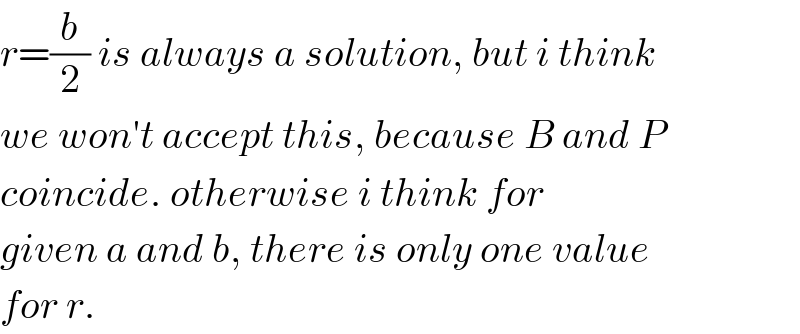
Question and Answers Forum
Question Number 88673 by ajfour last updated on 12/Apr/20

Commented by john santu last updated on 12/Apr/20

Commented by ajfour last updated on 12/Apr/20

Answered by mr W last updated on 12/Apr/20

Commented by mr W last updated on 12/Apr/20

Commented by ajfour last updated on 12/Apr/20

Commented by mr W last updated on 12/Apr/20

Commented by ajfour last updated on 12/Apr/20

Commented by mr W last updated on 12/Apr/20

Answered by mr W last updated on 12/Apr/20
![A(a,0) B(0,2r) say P(a cos θ, b sin θ) P must be on line AB: ((b sin θ)/(a cos θ−a))=((2r)/(−a)) ⇒b sin θ+2r cos θ=2r let μ=(b/a), λ=(r/a) ⇒(r/a)=λ=((μ sin θ)/(2(1−cos θ))) P must be on circle: (a cos θ)^2 +(b sin θ−r)^2 =r^2 (a^2 −b^2 ) sin^2 θ+2br sin θ−a^2 =0 (1−μ^2 )(1−cos^2 θ)+μ^2 (1+cos θ)−1=0 [(1−μ^2 )cos θ−μ^2 ]cos θ=0 ⇒cos θ=0 ⇒ not accepted ⇒cos θ=(μ^2 /(1−μ^2 )) ⇒sin θ=((√(1−2μ^2 ))/(1−μ^2 )) λ=(μ/(2(1−(μ^2 /(1−μ^2 )))))×((√(1−2μ^2 ))/(1−μ^2 )) ⇒λ=(μ/(2(√(1−2μ^2 )))) ⇒r=((ab)/(2(√(a^2 −2b^2 )))) with a>(√2)b](Q88694.png)
Commented by mr W last updated on 12/Apr/20

Commented by mr W last updated on 12/Apr/20

Commented by ajfour last updated on 12/Apr/20

Commented by mr W last updated on 12/Apr/20

